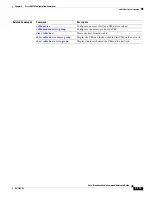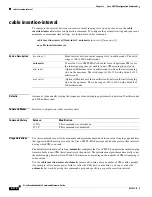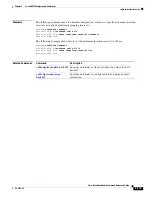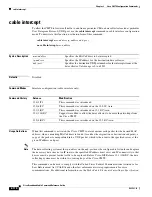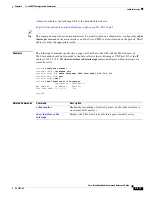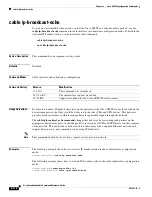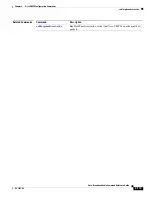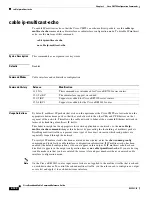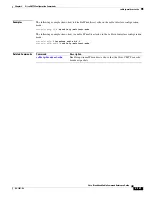
2-106
Cisco Broadband Cable Command Reference Guide
OL-1581-08
Chapter 2 Cisco CMTS Configuration Commands
cable freq-range
Typically, the
upstream freq-range
command is not needed because the default behavior covers the
most common configurations. However, this command can be used in the following situations:
•
This command is required to enable EuroDOCSIS operations on the Cisco uBR-MC16U/X and
Cisco uBR-MC28U/X cards.
•
This command is never needed for the Cisco uBR-MC5X20U card nor for EuroDOCSIS cable
interfaces (Cisco uBR-MC16E card, and the Cisco uBR7111E and Cisco uBR7114E routers),
because these interfaces default to the EuroDOCSIS range of frequencies. However, if you have
previously used this command to restrict the allowable range of frequencies, you must use the
european
option to re-enable the EuroDOCSIS range of frequencies.
•
The
north-american
option is usually not needed, because this is the default mode of operations for
all DOCSIS cable interfaces. However, this option can be useful on the Cisco uBR-MC16U/X and
Cisco uBR-MC28U/X cards when noise exists on the frequencies above 42 MHz. In this situation,
using the
north-american
option filters out the higher frequencies and reduces the impact of that
noise.
•
Similarly, the
japanese
option is not needed on those cable interface cards that support it, because
this is the default configuration on those cards. However, if you have previously used the
north-
american
option on an interface, you need to use the
japanese
option to re-enable the extended
frequency range.
•
Even when the
upstream freq-range
command is not needed to enable a frequency range, using it
ensures that the
cable upstream frequency
and
cable spectrum-group
commands allow only
frequencies that are within the desired range. This can help operators from assigning invalid
frequencies to upstreams.
Tip
If one or more cable interface line cards that are installed in the chassis do not support the frequency
range that you select with this command, the command displays an informational warning message for
each of those cable interface cards. Also, you cannot configure the router for a particular frequency range
if an upstream or spectrum group on the router is currently configured for a frequency that is invalid for
the new range. If you try to do so, the command is ignored and a warning message is printed prompting
you to reconfigure the upstream or spectrum group before retrying the command.
Note
This command configures only the range of frequencies that can be configured on an upstream. It does
not configure the upstreams for the DOCSIS (Annex B) or EuroDOCSIS (Annex A) modes of operation,
which is done using the
cable downstream annex
interface command. (Annex C mode is not supported.)
You must configure the downstream for Annex A for EuroDOCSIS operations and Annex B for DOCSIS
operations. You can configure certain cable interface cards (such as the Cisco uBR-MC28U) for both the
DOCSIS Annex B mode and the EuroDOCSIS frequency range, but this violates the DOCSIS
specifications and should not be used on standard DOCSIS networks.
The allowable range for the upstream channel frequency depends on the cable interface line card and
Cisco IOS software release being used. See
Table 2-11
for the currently supported values.






















